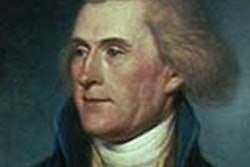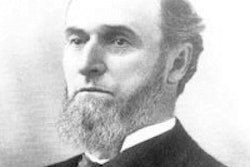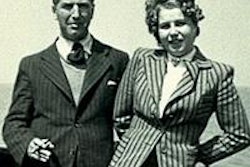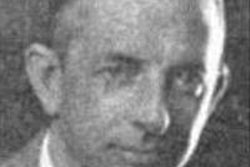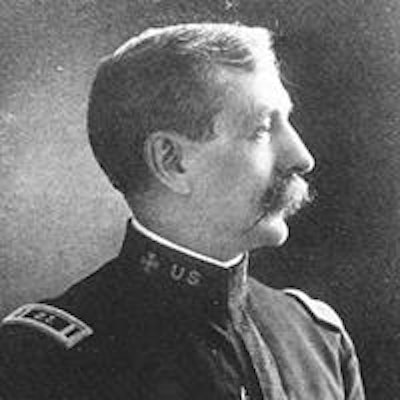
In 1901, Chicago dentist Dr. John Sayre Marshall, MD, told a St. Paul Globe newspaper reporter that during the U.S. Civil War he witnessed a "soldier sit in a dentist's chair and undergo the tortures of Hades [hell]." The soldier was having a tooth pulled. According to Dr. Marshall, "the alleged dentist who treated him -- a hospital steward [i.e., a medic] -- inserted a turnkey into his face and attempted to pull the tooth. He twisted, yanked, drew, and jerked, until the tooth finally came out. Incidental to the extraction of the tooth, he broke the patient's jaw," adding "he almost killed the poor fellow."
 A peavey is a cant hook with a point.
A peavey is a cant hook with a point.
Dr. Marshall explained that a turnkey was an "instrument that somewhat resembled the cant hook of the lumberman." Another common instrument he had witnessed stewards using were "tack hammers." Other accounts reveal hospital stewards used anything handy from "a brass tack to a sledgehammer." One era newspaper article noted "soldiers of the nation have suffered the tortures of the unmentionable in this respect ... [resulting] in broken jawbones ... [and lifelong] ... disfigurement."
Dr. Marshall had just recently been appointed the nation's first dental surgeon under a law enacted by Congress that authorized the hiring of 30 dentists by the U.S. Army. According to a 1940 paper on the founding of the Dental Corps authored by Lt. Col. W.D. Vail, DDS, Dr. Marshall's job as president of the examining board "was to [oversee the] selection of qualified dentists, provide them with suitable equipment, [see to] their distribution throughout the service, and to prescribe methods of procedure that would insure the greatest efficiency for the number of dentists employed."
Originally from England, Marshall immigrated at the age of 12 with his parents to the U.S. in 1858 and settled in Upstate New York. At 18, he volunteered and served as an enlisted man during the American Civil War, in which he participated in a number of the culminating combat engagements, including Appomattox, where his unit witnessed General Robert E. Lee's surrender to General Ulysses S. Grant.
 Dr. John Sayre Marshall, MD (1846-1922).
Dr. John Sayre Marshall, MD (1846-1922).
After the war, he returned to New York, where he completed his schooling at the Fayettesville Academy, graduating in 1868. That same year, he apprenticed himself to two local dentists and was certified to practice dentistry a year later. Four years later, according to Lt. Col. Vail, "realizing the importance of a thorough education," Dr. Marshall matriculated at the medical school of the University of Syracuse, where he graduated with a Doctor of Medicine in 1876. Upon graduation, he joined the medical school faculty as a professor of oral and dental surgery -- a position he vacated in 1883 when he moved to Chicago.
In Chicago, he opened a private dental practice and was also appointed as an instructor in dental and oral surgery in the faculty at Northwestern University School of Medicine. He was asked to organize the university's dental school and was appointed its first dean and professor of dental pathology. Historical records indicate his greatest pleasure was harelip and cleft palate reconstructive surgery, in which he specialized. While at Northwestern, he authored two scholarly texts: one on injuries and diseases associated with the face and mouth and one on dentistry. He resigned this position in 1896 and continued his private practice in Chicago. He also reorganized the American Dental College, which was merged into Northwestern's.
According to a 2009 study by Maj. Gen. Patrick Sculley, "the National Dental Association [now American Dental Association] had been pressing Congress to create a cadre of dental surgeons for the Army and Navy. In fact, its efforts extend back to its first convention in Washington, DC, in 1860 when it petitioned Congress to create a dental establishment for the services. Unfortunately, it was 41 years before a limited success was achieved."
The Spanish-American War in 1898 resulted in the acquisition of Cuba, the Dominican Republic, the Philippines, and other Spanish tropical colonies and finally pushed Congress to create an army dental corps and with it the appointment of Dr. Marshall. He explained to an assemblage of the National Dental Association, "campaigning in the tropics where conditions of the climate and necessary changes in the habits of life are so enervating and debilitating to the general system." Resistance to disease under these conditions is greatly lessened, and the individual is consequently predisposed to a certain class of diseases, among which are dental caries, pulpitis, pericementitis, dentoalveolar abscess, pyorrhea alveolaris, necrosis of the jaws, and inflammatory and ulcerative conditions of the gums, oral mucous membrane, throat, and tongue, he said.
Dr. Marshall, along with two other dentists, Dr. Robert Oliver of Indianapolis and Dr. Robert Morgan of Lynchburg, VA, was appointed to the examining board. The board spent nearly six months culling through 1,000 candidates who applied for the 30 positions. They settled on 87 whom they interviewed and tested. The position would pay $150 per month (equivalent to $4,600 in current values). It's worth noting that at the time there were no federal or state income taxes imposed on wage earnings. Besides the salary, they would also receive the normal perks associated with the military, such as base housing, food, and medical care. The law also provided that the contract dentists were obligated to work for the army for eight hours a day, after which they could dedicate two hours to treat soldiers' families and civilian employees for which they could charge "the regular fee." Military dependants were not covered under the legislation.
All candidates for the new jobs had to be between the ages of 24 and 40 and graduates of a dental college. The first week of the testing was devoted to a theoretical examination (i.e., dental anatomy, physiology, histology, chemistry, metallurgy, etc.) and the second involved examining prosthetic dentistry (i.e., "making artificial teeth, crowns, bridges, and interdental splints and the like").
Dr. Marshall was appalled at the lack of education among the 87 dentists who did make it through to the examining and interview level. He reported that many candidates were unable to write a sentence of 20 words without misspelling one-fourth of them. He blamed "the ambition to obtain wealth and position by the shortest possible route" as the root cause of a bigger problem. The ultimate culprits were many dental colleges who "when there is a deficit in the college treasury [they] wink at the meager qualifications possessed by the applicants for admission, and trust the future to correct this deficiency." As a result, Dr. Marshall was one of the first -- if not the first -- dental professional to advocate the "need of raising the standard of entrance requirements and of lengthening a course of instruction to four years."
Once the candidates were chosen, Dr. Marshall was obligated to assign the successful ones to various posts around the U.S. and overseas. He was assigned to the Presidio in San Francisco, where he presided over the fledging organization. Twenty were assigned to the Philippines, one to Cuba, one to the Dominican Republic, and the remainder scattered throughout the U.S. Each dentist was provided with a "kit of operating machinery ... each costing in the neighborhood of $300" ($7,200 in current values). The operating machinery and other dental paraphernalia were the same as found in offices of the "highest class of dentists in civil life," with the exception of the dental chair. In the army, dentists chairs were "a folding article of furniture and therefore portable." He bragged the "outfits [were] so light they can be carried on the backs of two mules." In 1901, the army was not mechanized.
The legislation, as enacted by Congress, provided that the dentists would not be actual soldiers but "contract dentists" with a pay grade equivalent to a first lieutenant. The reason being that many in Congress were skeptical about the need for dentists at all. The compromise reached essentially made the first 30 dentists guinea pigs and was an experiment to determine if a dental corps was a useful adjunct to the army.
By 1903, Dr. Marshall was able to report remarkable successes: "The services of the Dental Corps have been highly appreciated by officers and enlisted men of the Regular and Volunteer Armies and have proved very satisfactory to the Medical Department, because they have been able to relieve a great amount of acute suffering and to conserve a large number of teeth and restore them to a healthy condition, thus almost immediately returning to duty many cases that were previously carried for several days on the company sick report. This has resulted in greatly reducing the loss of valuable time to the service, incident to diseases of the mouth, teeth, and jaws, and relieving and hastening the cure of such gastric and intestinal disorders as were due to defective mastication and infective and suppurative conditions of the teeth and oral cavity."
From the moment he took office, Dr. Marshall fought for the inclusion of dentists within the officers ranks. He finally attained his dream in 1911, at age 65, when Congress authorized a dental corps made up of officers. He was the first dentist commissioned as a first lieutenant -- the same day that he was forced to retire from the army because of mandatory age limitations. A few weeks later, he was advanced to the grade of captain by including his Civil War service for pension purposes -- likely a pat on the back for a job well done.
Army life as a result of the new contract organization "will be one grand, sweet song," according to a Washington Evening Star newspaper reporter in 1901. "There will be no more twisting of molars, lacerating of gums, boring of bones, breaking, smashing, or splintering of the maxillary property. There will be no more thrusting of blacksmith's tools, turnkeys, or miniature cant hooks into the terrorized face of the soldier victim by the hospital steward, and no more of the unnecessary pain, tribulation, and disfigurement attending the operation of filling or pulling a tooth in the army."
Dr. Marshall certainly saw to that. Today, every member of the U.S. armed services enjoys the benefits of the pioneering efforts of Dr. Marshall -- the man recognized as the father of army dentistry.
Dr. Marshall retired to Berkeley, CA, where he became affiliated with the University of California. He volunteered to return to duty for World War I, but his services were declined due to his age. He continued to research and write about the science of dentistry until the day he died in 1922. He was 76.
Daniel Demers is a semiretired businessman whose hobby is researching and writing about 19th and 20th century historical events and personalities. He holds a bachelor's degree in history from George Washington University and a master's degree in business from Chapman University. You can review his other published works at www.danieldemers.com.
Sources
Books
Marshal JS. A Manual of the Injuries and Diseases of the Face, Mouth, and Jaws. Philadelphia, PA: S.S. White Dental Manufacturing Company; 1902. https://archive.org/details/manualofinjuries00mars.
Marshal JS. Principal and Practice of Operative Dentistry. Philadelphia, PA: J.B. Lippincott Company; 1920. https://archive.org/details/principlespra00mars.
Newspapers
The Army Dentists. Evening Star. July 13, 1901:8.
The Army Dentists. Times. February 8, 1901:7.
Army Reorganization. Record Union. December 21, 1898:6.
That Army Bill. St. Paul Globe. June 7, 1901:1.
Journals/papers
Marshall JS. Organization of the Dental Corps of the U. S. Army, with suggestions upon the educational requirements for military dental practice. Report to 1901 National Dental Association meeting. http://history.amedd.army.mil/corps/dental/general/marshall_report.html. Accessed December 1, 2013.
Scully P. Our Founder, Life of John Marshall. Association of Army Dentistry, as presented at the Ft. Carson 98th Army Dental Corps Anniversary. March 1, 2009. http://www.associationofarmydentistry.org/?page_id=107. Accessed November 29, 2013.
Vail WD. John Sayre Marshall, Pioneer Army Dental Surgeon. Dental Bulletin. 1940;11(3). http://history.amedd.army.mil/corps/dental/general/vail/jsm.html. Accessed November 29, 2013.
Websites
Cant hook. Wikipedia website. https://en.wikipedia.org/wiki/Cant_hook. Accessed November 28, 2013.
Upholstery hammer. Wikipedia website. https://en.wikipedia.org/wiki/Upholstery_hammer. Accessed November 28, 2013.




